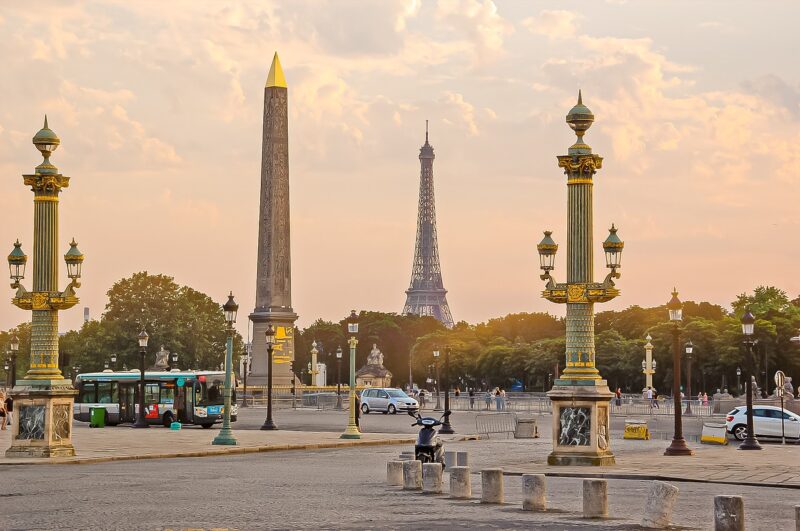Nestled in the heart of Paris, the Tuileries Garden stands as a verdant oasis amidst the bustling cityscape. This iconic garden, with its lush greenery, vibrant flowerbeds, and historic sculptures, offers a serene escape for both locals and tourists. Its historical significance and breathtaking beauty make it a must-visit destination.
Table of Contents
History of the Tuileries Garden
Origins and Early Years
The Tuileries Garden dates back to 1564 when it was created by Catherine de’ Medici as the garden of the Tuileries Palace. Named after the tile factories (tuileries) that previously occupied the site, the garden quickly became a symbol of royal prestige.
The Renaissance Influence
Influenced by the Italian Renaissance gardens, the Tuileries were initially designed with an Italian flair, featuring intricate patterns and ornamental elements.
Transformation under André Le Nôtre
In the 17th century, André Le Nôtre, the famous landscape architect, transformed the garden into a formal French garden. His design included symmetrical patterns, wide walkways, and grand vistas, which have largely shaped the garden’s current layout.
Role during the French Revolution
During the French Revolution, the Tuileries Garden became a public park. It witnessed significant historical events, including the fall of the Tuileries Palace and the subsequent establishment of the garden as a symbol of the Republic.
19th and 20th-century Changes
Over the centuries, the garden underwent several modifications, including the addition of statues, fountains, and various horticultural enhancements. It evolved into a cultural hub, hosting art exhibitions and public gatherings.
Location and Layout
Geographic Location in Paris
The Tuileries Garden is strategically located between the Louvre Museum and Place de la Concorde, bordered by the Seine River and Rue de Rivoli. Its central location makes it easily accessible and a focal point of Parisian life.
General Layout and Design
The garden spans approximately 55 acres and is divided into distinct sections, each offering unique attractions and experiences. The formal French design is characterized by orderly paths, manicured lawns, and geometric flower beds.
Key Sections of the Garden
The garden is broadly divided into the Grand Carré, the Grand Couvert, and several smaller areas featuring fountains, sculptures, and seating arrangements. Each section has its own charm and historical significance.
Main Attractions
The Grand Carré
The Grand Carré is the central part of the garden, showcasing meticulously maintained lawns and flowerbeds. It’s a favorite spot for picnics and leisurely strolls.
The Grand Couvert
This wooded area provides a shaded retreat with its dense canopy of trees. It’s perfect for a quiet escape from the sun.
The Round Basin and Fountain
At the heart of the garden lies the Round Basin, surrounded by seating where visitors can relax and enjoy the views. The fountain adds a dynamic element to the tranquil setting.
The Arc de Triomphe du Carrousel
Located near the Louvre, this triumphal arch is a historical monument commemorating Napoleon’s victories. It’s an iconic landmark within the garden.
The Statues and Sculptures
Scattered throughout the garden are numerous statues and sculptures by renowned artists, adding an artistic touch to the natural beauty.
The Louvre and the Tuileries
Historical Connection to the Louvre
Originally, the Tuileries Garden was part of the Tuileries Palace complex, which served as a royal residence. The garden was directly connected to the Louvre, symbolizing royal power and cultural sophistication.
Current Relationship and Integration
Today, the garden and the Louvre remain closely linked, with the garden providing a picturesque approach to the museum. Visitors often combine a visit to both attractions, enhancing their cultural experience.
Seasonal Beauty
Spring Blossoms and Greenery
In spring, the Tuileries Garden comes alive with blooming flowers and vibrant greenery. The colorful tulips and daffodils create a spectacular display.
Summer Vibrancy
Summer sees the garden at its most lively, with lush lawns, busy walkways, and various events. The long days allow plenty of time to explore every corner.
Autumn brings a stunning transformation as the leaves turn shades of red, orange, and yellow. This season offers a peaceful and picturesque setting, perfect for leisurely walks and photography.
Winter Charm
Even in winter, the Tuileries Garden has its own unique charm. The bare trees and serene atmosphere provide a tranquil escape from the city’s hustle and bustle. Occasionally, a light dusting of snow can create a magical scene.
Cultural Significance
Influence on French Garden Design
The Tuileries Garden has had a profound influence on the design of French gardens. Its formal layout, symmetry, and use of water features have inspired numerous gardens across France and beyond.
Depictions in Art and Literature
Throughout history, the Tuileries Garden has been depicted in countless works of art and literature. Artists like Édouard Manet and Claude Monet have captured its beauty on canvas, while writers have immortalized it in prose and poetry.
Events and Activities
Annual Events and Festivals
The Tuileries Garden hosts various annual events, including the Fête des Tuileries, a traditional funfair held every summer. The garden is also a venue for open-air art exhibitions and cultural festivals.
Regular Activities for Visitors
Visitors to the garden can enjoy a range of activities, from leisurely walks and picnics to boat rides on the Round Basin. There are also playgrounds for children and spaces for sports and exercise.
Visitor Experience
Best Times to Visit
The garden is beautiful year-round, but the best times to visit are during the spring and fall when the weather is mild, and the garden is at its most colorful.
Guided Tours and Self-Guided Walks
For those interested in learning more about the garden’s history and features, guided tours are available. Alternatively, visitors can explore on their own, using maps and information boards scattered throughout the garden.
Amenities Available
The Tuileries Garden offers various amenities, including restrooms, drinking fountains, and benches. There are also several cafés and kiosks where visitors can purchase refreshments.
Gardens for Children
Play Areas and Attractions for Kids
The Tuileries Garden is a family-friendly destination with several play areas for children. These include playgrounds with swings, slides, and climbing structures, as well as a carousel and puppet theater.
Educational Programs
The garden also offers educational programs and workshops for children, focusing on horticulture, history, and art. These programs provide a fun and engaging way for kids to learn while enjoying the garden.
Photography Tips
Best Spots for Photos
For those looking to capture the beauty of the Tuileries Garden, some of the best spots include the Round Basin, the Arc de Triomphe du Carrousel, and the flower beds of the Grand Carré.
Time of Day for the Best Lighting
The best time for photography is during the golden hours of early morning and late afternoon when the light is soft and warm. This enhances the colors and provides a magical glow to the scenery.
Dining and Refreshments
Cafés and Eateries within the Garden
There are several charming cafés and eateries within the Tuileries Garden where visitors can enjoy a meal or a snack. These spots offer a variety of options, from light bites to full meals, and provide beautiful views of the garden.
Picnic Spots
For those who prefer to bring their own food, there are numerous picnic spots throughout the garden. Visitors can spread a blanket on the grass or find a bench to enjoy their meal while soaking in the surroundings.
Nearby Attractions
Proximity to Other Landmarks
The Tuileries Garden is surrounded by several notable landmarks. Besides the Louvre Museum, it is close to the Place de la Concorde, the Musée de l’Orangerie, and the Champs-Élysées. This makes it an ideal starting point for exploring central Paris.
Suggested Itineraries
A popular itinerary includes starting at the Louvre, strolling through the Tuileries Garden, and continuing to the Place de la Concorde and down the Champs-Élysées. This route provides a comprehensive experience of Paris’s historical and cultural highlights.
Preservation and Maintenance
Efforts to Preserve the Garden
Maintaining the Tuileries Garden’s historical and aesthetic integrity is a priority. Various organizations and government bodies are involved in its preservation, ensuring that it remains a beautiful and accessible space for future generations.
Maintenance Routines
The garden is meticulously maintained with regular pruning, planting, and cleaning. This ensures that the garden remains in pristine condition year-round, providing a pleasant experience for all visitors.
Conclusion
The Tuileries Garden is more than just a park; it’s a living piece of history, a cultural icon, and a serene retreat in the heart of Paris. Whether you’re a history buff, an art lover, or simply looking for a peaceful place to relax, the Tuileries Garden has something to offer. Its blend of natural beauty, historical significance, and cultural richness makes it a must-visit destination for anyone exploring the City of Light.
FAQs
What are the opening hours of the Tuileries Garden?
The Tuileries Garden is typically open from 7:00 AM to 9:00 PM in the summer and from 7:30 AM to 7:30 PM in the winter. However, hours can vary, so it’s best to check ahead of your visit.
Is there an entrance fee for the Tuileries Garden?
No, the Tuileries Garden is free to enter and open to the public. It’s a wonderful place to enjoy without any cost.
Are pets allowed in the Tuileries Garden?
Yes, pets are allowed in the Tuileries Garden, but they must be kept on a leash. Owners are also expected to clean up after their pets to maintain the garden’s cleanliness.
What is the best way to reach the Tuileries Garden?
The garden is easily accessible by public transportation. The closest metro stations are Tuileries (Line 1) and Concorde (Lines 1, 8, and 12). It’s also within walking distance from several central Paris landmarks.
Are there any guided tours available?
Yes, there are guided tours available that provide detailed insights into the garden’s history, design, and attractions. These tours are a great way to enhance your visit and learn more about this historic site.









